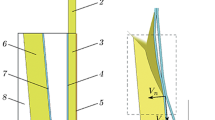Abstract
The acceleration ability of an emulsion explosive sensitized with Expancel polymer microballoons and having an initial density of 0.193–1.2 g/cm3 was measured using the end acceleration method and the method of acceleration of a cylindrical shell. The results were compared with those obtained for 79/21 AN/TNT and with the results of ANSYS AUTODYN simulation.
Similar content being viewed by others
References
E. V. Kolganov and V. A. Sosnin, Commercial Emulsion Explosives, Book 1: Compositions and Properties (Kristal, Dzerzhinsk, 2009) [in Russian].
A. S. Yunoshev, S. I. Rafeichik, A. V. Plastinin, and V. V. Sil’vestrov, “New Applications of Emulsion Explosive Compositions,” Fiz. Goreniya Vzryva 49 (2), 113–118 (2013) [Combust., Expl., Shock Waves 49 (2), 231–237 (2013).
B. S. Zlobin, V. V. Kiselev, A. A. Shtertser, and A. V.‘Plastinin, “Use of Emulsion Explosives in Experimental Studies of Flows in the Bonding Zone in Explosive Welding,” Fiz. Goreniya Vzryva 54 (2), 114–121 (2018) [Combust., Expl., Shock Waves 54 (2), 231–237 (2018)].
A. S. Yunoshev, A. V. Plastinin, and S. I. Rafeichik, “Detonation Velocity of an Emulsion Explosive Sensitized with Polymer Microballoons,” Fiz. Goreniya Vzryva 53 (6), 132–137 (2017) [Combust., Expl., Shock Waves 53 (6), 738–743 (2017)].
Physics of Explosion, Ed. by L. P. Orlenko (Fizmatlit, Moscow, 2004), Vol. 1 [in Russian].
A. A. Deribas, Physics of Explosive Hardening and Welding (Nauka, Novosibirsk, 1980) [in Russian].
J. A. Sanchidri´an, R. Castedo, L. M. López, P. Segarra, A. P. Santos, “Determination of the JWL Constants for ANFO and Emulsion Explosives from Cylinder Test Data,” CEJEM 12 (2), 177–194 (2015).
H. Hanson, “Determination of Properties for Emulsion Explosives using Cylinder Expansion Tests and Numerical Simulation,” Swebrec Report (2009).
H. Hamashima, Y. Kato,and S. Itoh, “Determination of JWL Parameters for Nonideal Explosive,” in Shock Compression of Condensed Matter, 2003 (AIP, 2004), pp. 331–334.
A. S. Yunoshev, A. V. Plastinin, and V. V. Sil’vestrov, “Investigation of the Influence of the Density of the Emulsion Explosive to the Width of the Reaction Zone,” Fiz. Goreniya Vzryva 48 (3), 79–88 (2012) [Combust., Expl., Shock Waves 48 (3), 319–327 (2012)].
J. B. Ribeiro, C. Silva, and R. Mendes, “Estimation of the Reactive flow Model Parameters for an Ammonium Nitrate-Based Emulsion Explosive using Genetic Algorithms,” J. Energ. Mater. 28, 180–204 (2010).
Author information
Authors and Affiliations
Corresponding author
Additional information
Original Russian Text © A.S. Yunoshev, A.V. Plastinin, S.I. Rafeichik, M.S. Voronin.
Published in Fizika Goreniya i Vzryva, Vol. 54, No. 4, pp. 123–129, July–August, 2018.
Rights and permissions
About this article
Cite this article
Yunoshev, A.S., Plastinin, A.V., Rafeichik, S.I. et al. Acceleration Ability of Emulsion Explosives. Combust Explos Shock Waves 54, 496–501 (2018). https://doi.org/10.1134/S0010508218040135
Received:
Published:
Issue Date:
DOI: https://doi.org/10.1134/S0010508218040135



